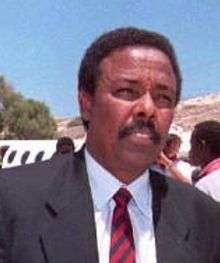Ali Mahdi Muhammad
| Ali Mahdi Muhammad علي مهدي محمد | |
|---|---|
 | |
| 4th President of Somalia | |
|
In office January 1991 – January 1997 | |
| Preceded by | Siad Barre |
| Succeeded by |
vacant (3 January 1997-27 August 2000); Abdiqasim Salad Hassan afterwards |
| Personal details | |
| Born |
1 January 1939 Jowhar |
| Nationality | Somali |
| Political party | United Somali Congress |
| Religion | Sunni Islam |
Ali Mahdi Muhammad (Somali: Cali Mahdi Maxamed, Arabic: علي مهدي محمد) (born 1939) is a Somali entrepreneur and politician. He served as President of Somalia from January 1991 to January 1997.
Muhammad rose to power after a coalition of armed opposition groups, including his own United Somali Congress, deposed longtime President Siad Barre. However, Muhammad was not able to exert his authority beyond parts of the capital. Power was instead vied with other faction leaders in the southern half of the country and with autonomous subnational entities in the north.
Early life
Muhammad was born in 1939,[1] in Jowhar, an agricultural town in the southern Middle Shebelle region of Somalia (then a colony of Italy known as Italian Somaliland). His family hails from the Abgaal Hawiye clan.[1]
Career
United Somali Congress
Muhammad began his career in business, working as an independent Mogadishu-based entrepreneur.
After fallout from the unsuccessful Ogaden campaign of the late 1970s, the Siad Barre administration began arresting government and military officials under suspicion of participation in the abortive 1978 coup d'état.[2][3] Most of the people who had allegedly helped plot the putsch were summarily executed.[4] However, several officials managed to escape abroad and started to form the first of various dissident groups dedicated to ousting Barre's regime by force.[5]
By the late 1980s, Barre's regime had grown considerably unpopular. The authorities became increasingly totalitarian, and resistance movements, supported by Ethiopia's communist Derg administration, sprang up across the country. This eventually led in 1991 to the outbreak of the civil war, the toppling of Barre's government, and the disbandment of the Somali National Army (SNA). Many of the opposition groups subsequently began competing for influence in the power vacuum that followed the ouster of Barre's regime. Armed factions led by United Somali Congress (USC) commanders Ali Mahdi Muhammad and General Mohamed Farah Aidid, in particular, clashed as each sought to exert authority over the capital.[6]
President of Somalia
In 1991, a multi-phased international conference on Somalia was held in neighbouring Djibouti. Aidid boycotted the first meeting in protest. Due to the legitimacy conferred on Muhammad by the Djibouti conference, he was subsequently recognized by the international community as the new President of Somalia. Djibouti, Egypt, Saudi Arabia and Italy were among the countries that officially extended recognition to Muhammad's administration.[7] However, he was not able to exert his authority beyond parts of the capital. Power was instead vied with other faction leaders in the southern half of the country and with autonomous subnational entities in the north.[8] The competition for influence and resources between Muhammad and Aidid continued on through the 1992–95 UN missions to Somalia (UNOSOM I, UNOSOM II, and UNITAF), until Aidid's eventual death in 1996.
In 2000, Muhammad participated in another conference in Djibouti, where he lost a re-election bid to Barre's former Interior Minister Abdiqasim Salad Hassan. Muhammad gave a concession speech, indicating that he respected the outcome of the election and would support and work with the new President-elect.
As of 2013, Muhammad lives on his farm on the outskirts of Mogadishu.
References
- 1 2 Metz, Helen Chapin (1993). Somalia: a country study. The Division. p. 155. ISBN 0844407755. Retrieved 10 June 2014.
- ↑ ARR: Arab report and record, (Economic Features, ltd.: 1978), p.602.
- ↑ Ahmed III, Abdul. "Brothers in Arms Part I" (PDF). WardheerNews. Retrieved February 28, 2012.
- ↑ New People Media Centre, New people, Issues 94–105, (New People Media Centre: Comboni Missionaries, 2005).
- ↑ Nina J. Fitzgerald, Somalia: issues, history, and bibliography, (Nova Publishers: 2002), p.25.
- ↑ Library Information and Research Service, The Middle East: Abstracts and index, Volume 2, (Library Information and Research Service: 1999), p.327.
- ↑ Paul Fricska, Szilard. "Harbinger of a New World Order? Humanitarian Intervention in Somalia" (PDF). University of British Columbia. Retrieved 6 October 2013.
- ↑ "Somalia: Some key actors in the transitional process". IRIN. 2005-05-06. Retrieved 2007-02-07.
| Political offices | ||
|---|---|---|
| Preceded by Muhammad Siad Barre |
President of Somalia 1991 – 1997 |
Succeeded by Vacant - post next held by Abdiqasim Salad Hassan |
